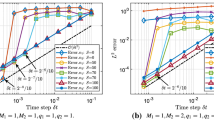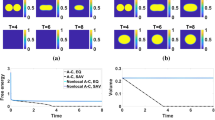Abstract
In this paper, we propose a first order energy stable linear semi-implicit method for solving the Allen–Cahn–Ohta–Kawasaki equation. By introducing a new nonlinear term in the Ohta–Kawasaki free energy functional, all the system forces in the dynamics are localized near the interfaces which results in the desired hyperbolic tangent profile. In our numerical method, the time discretization is done by some stabilization technique in which some extra nonlocal but linear term is introduced and treated explicitly together with other linear terms, while other nonlinear and nonlocal terms are treated implicitly. The spatial discretization is performed by the Fourier collocation method with FFT-based fast implementations. The energy stabilities are proved for this method in both semi-discretization and full discretization levels. Numerical experiments indicate the force localization and desire hyperbolic tangent profile due to the new nonlinear term. We test the first order temporal convergence rate of the proposed scheme. We also present hexagonal bubble assembly as one type of equilibrium for the Ohta–Kawasaki model. Additionally, the two-third law between the number of bubbles and the strength of long-range interaction is verified which agrees with the theoretical studies.



Similar content being viewed by others
References
Ohta, T., Kawasaki, K.: Equilibrium morphology of block copolymer melts. Macromolecules 19(10), 2621–2632 (1986)
Hamley, I.: Developments in Block Copolymer Science and Technology. Wiley, New York (2004)
Camley, B., Zhao, Y., Li, B., Levine, H., Rappel, W.-J.: Periodic migration in a physical model of cells on micropatterns. Phys. Rev. Lett. 111, 158102 (2013)
Zhao, Y., Ma, Y., Sun, H., Li, B., Du, Q.: A new phase-field approach to variational implicit solvation of charged molecules with the Coulomb-field approximation. Commun. Math. Sci. 16, 1203–1223 (2018)
Du, Q., Liu, C., Ryham, R., Wang, X.: A phase field formulation of the Willmore problem. Nonlinearity 18, 1249–1267 (2005)
Wang, X.: Asymptotic analysis of phase field formulations of bending elasticity models. SIAM J. Math. Anal. 39, 1367–1401 (2008)
Li, B., Zhao, Y.: Variational implicit solvation with solute molecular mechanics: from diffuse interface to sharp interface models. SIAM J. Appl. Math. 73, 1–23 (2013)
Shen, J., Yang, X.: Numerical approximations of Allen–Cahn and Cahn–Hilliard equations. Discrete Contin. Dyn. Syst. A 28, 1669 (2010)
Wise, S., Wang, C., Lowengrub, J.: An energy stable and convergent finite difference scheme for the phase field crystal equation. SIAM J. Numer. Anal. 47, 2269–2288 (2009)
Hu, Z., Wise, S., Wang, C., Lowengrub, J.: Stable and efficient finite-difference nonlinear-multigrid scheme for the phase field crystal equation. J. Comput. Phys. 228, 5323–5339 (2009)
Wang, C., Wise, S.: An energy stable and convergent finite-difference scheme for the modified phase field crystal equation. SIAM J. Numer. Anal. 49, 945–969 (2011)
Shen, J., Wang, C., Wang, X., Wise, S.: Second-order convex splitting schemes for gradient flows with Ehrlich–Schwoebel type energy: application to think film epitaxy. SIAM J. Numer. Anal. 50, 105–125 (2012)
Chen, W., Conde, S., Wang, C., Wang, X., Wise, S.: A linear energy stable scheme for a thin film model without slope selection. J. Sci. Comput. 52, 546–562 (2012)
Eyre, D.: Unconditionally gradient stable time marching the Cahn–Hillard equation. In: Computational and Mathematical Models of Microstructural Evolution (San Francisco, CA, 1998), Materials Research Society Symposia Proceedings, vol. 529, p. 39 (1998)
Xu, C., Tang, T.: Stability analysis of large time-stepping methods for epitaxial growth models. SIAM J. Numer. Anal. 44, 1759 (2006)
Cheng, W., Yang, X., Shen, J.: Efficient and accurate numerical schemes for a hydro-dynamically coupled phase field diblock copolymer model. J. Comput. Phys. 341, 44 (2017)
Yang, X.: Linear and unconditionally energy stable numerical schemes for the phase field model of homopolymer blends. J. Comput. Phys. 302, 509 (2016)
Benesova, B., Melcher, C., Suli, E.: An implicit midpoint spectral approximation of nonlocal Cahn–Hilliard equations. SIAM J. Numer. Anal. 52, 1466 (2014)
Caffarelli, L., Muler, N.E.: A \({L}^{\infty }\) bound for solutions of the Cahn–Hilliard equation. Arch. Ration. Mech. Anal. 133, 129–144 (1995)
Ju, L., Li, X., Qiao, Z., Zhang, H.: Energy stability and error estimates of exponential time differencing schemes for the epitaxial growth model without slope selection. Math. Comput. 87, 1859–1885 (2017)
Du, Q., Ju, L., Li, X., Qiao, Z.: Stabilized linear semi-implicit schemes for the nonlocal Cahn–Hilliard equation. J. Comput. Phys 363, 39–54 (2018)
Adams, R.A., Fournier, J.J.F.: Sobolev Spaces. Pure and Applied Mathematics Series, 2nd edn. Elsevier, Amsterdam (2003)
Camley, B., Zhao, Y., Li, B., Levine, H., Rappel, W.-J.: Crawling and turning in a minimal reaction-diffusion cell motility model: coupling cell shape and biochemistry. Phys. Rev. E 95, 012401 (2017)
Ren, X., Wei, J.: Many droplet pattern in the cylindrical phase of diblock copolymer morphology. Rev. Math. Phys. 19, 879 (2007)
Nakazawa, H., Ohta, T.: Microphase separation of ABC-type triblock copolymers. Macromolecules 26(20), 5503–5511 (1993)
Ren, X., Wei, J.: Triblock copolymer theory: free energy, disordered phase and weak segregation. Physica D 178(1–2), 103–117 (2003)
Ren, X., Wei, J.: A double bubble assembly as a new phase of a ternary inhibitory system. Arch. Ration. Mech. Anal. 215(3), 967–1034 (2015)
Wang, C., Ren, X., Zhao, Y.: Bubble assemblies in ternary systems with long range interaction. Comm. Math. Sci. (2019) (accepted)
Yan, Y., Chen, W., Wang, C., Wise, S.: A second-order energy stable BDF numerical scheme for the Cahn–Hilliard equation. Commun. Comput. Phys. 23, 572–602 (2018)
Wang, X., Ju, L., Du, Q.: Efficient and stable exponential time differencing Runge–Kutta methods for phase field elastic bending energy models. J. Comput. Phys. 316, 21–38 (2016)
Acknowledgements
Y. Zhao’s work is supported by Columbian College Facilitating Funds (CCFF 2018) of George Washington University and a grant from the Simons Foundation through Grant No. 357963.
Author information
Authors and Affiliations
Corresponding author
Additional information
Publisher's Note
Springer Nature remains neutral with regard to jurisdictional claims in published maps and institutional affiliations.
Rights and permissions
About this article
Cite this article
Xu, X., Zhao, Y. Energy Stable Semi-implicit Schemes for Allen–Cahn–Ohta–Kawasaki Model in Binary System. J Sci Comput 80, 1656–1680 (2019). https://doi.org/10.1007/s10915-019-00993-4
Received:
Revised:
Accepted:
Published:
Issue Date:
DOI: https://doi.org/10.1007/s10915-019-00993-4




